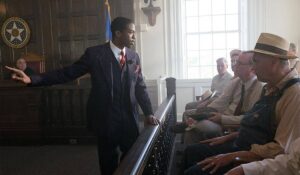by Kerry Torpey on February 15, 2018
Arts & Entertainment

by Patrick Fuller ’21
A&E Staff
Lawyer Thurgood Marshall an outstanding United States lawyer, won 29 of 32 Supreme Court cases in the U.S., the most cases ever argued. He had a sarcastic sense of humor, a raging compassion for the innocent, and an unparalleled tact in the courtroom.
As the chief counsel for the National Association for the Advancement of Colored People (NAACP), Marshall lead the integration movement, landing the Brown v. Board of Education decision to desegregate schools. He won the Spingarn Medal in in 1946 and the Presidential Medal of Freedom in 1993. And as Solicitor General, Marshall won 14 of the 19 cases put before him, until he served as the nation’s first African American justice on the national supreme court from 1967-1991.
Elizett Pires, Assistant director of Student Activities and Cultural Programming, made sure to pay homage to this American legend in Moore Hall on Feb. 8, showing a screening of the 2017 film Marshall. Directed by Reginald Hudlin, producer of Django Unchained, and written by Michael and Jacob Koskoff, the film put actor Chadwick Boseman, into Thurgood Marshall’s shoes in the year 1941.
In the film, Marshall teams up with an unqualified, inexperienced insurance lawyer named Sam Friedman, played by Josh Gad, to defend Joseph Spell, played by Sterling K Brown. Spell is accused of raping an affluent white woman, Eleanor Strubing, played by Kate Hudson, in Bridgeport, Connecticut and finds himself up against the forces of prejudice, deception, and social pressure.
When the white judge refuses to allow Marshall to argue the case, claiming it is because Marchall was not licensed to practice in Connecticut, but likely to send Spell to prison Marshall was not allowed to speak in court and can only work on the case behind the scenes. The life of the defendant, and the rights of African Americans everywhere, rest on the reluctant, originally unmotivated soulders of Sam Friedman.
This film not only follows the development of Friedman as a lawyer and a human being, but also supports Marshall’s fame in history and sheds light on African- Aericans’ long struggle for equality in the justice system. During this Black History Month, Marshall’s example is not one to be observed and remembered just by a select few. No matter your skin color, language, ethnicity, or belief system, Marshall proves what it means to be a virtuous human being dedicated to securing justice for the innocent, no matter the cost.
He was regularly insulted, physically beaten, and separated from his wife as he traveled throughout the country, fighting for the legal rights of African Americans. Marshall courageously stated for the first time that in the film that, “the forces of tyranny have unified under the decisions of a master race…from now on we claim the Constitution as our own.”
In the United States and Canada, the movie ended up making 3 million dollars, in its opening weekend and over 10 million dollars total, finishing 11th at the box office alongside Happy Death Day, The Foreigner, and Professor Marston and the Wonder Women. Rotten Tomatoes gave the film an 83 percent approval rating based on 125 reviews saying, “Marshall takes an illuminating, well-acted look at its real-life subject’s early career that also delivers as an entertainingly old-fashioned courtroom drama.” Rolling Stone critic Peter Travers also praised the film with three out of four stars, noting, “Charged by Boseman’s dramatic lightning, Marshall gives us an electrifying glimpse of a great man in the making.”
Furthermore, the movie’s song, “Stand Up for Something,” is nominated for Best Original Song in the Academy Awards coming up in March 2018.
Yet this film encourages viewers to notice not only the art form and focus on the history. The brilliance of the actors and actresses, the realistic costumes, cars, accents, and the beautiful cinematography merely lay the foundation for the celebration of one of America’s greatest citizens and the resilience of African Americans which continues to this day.